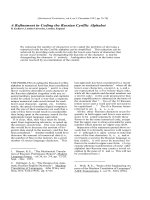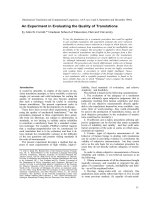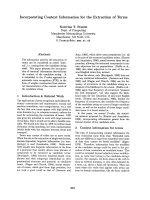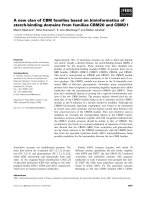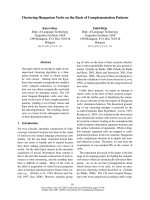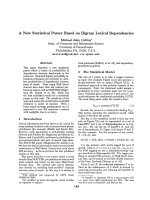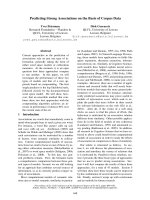Báo cáo khoa học: "A NEW VIEW ON THE PROCESS OF TRANSLATION" pdf
Bạn đang xem bản rút gọn của tài liệu. Xem và tải ngay bản đầy đủ của tài liệu tại đây (665.19 KB, 9 trang )
A NEW VIEW ON THE PROCESS OF TRANSLATION
John A. Bateman, Robert T. Kasper
Information Sciences Institute
University of Southern California
4676 Admiralty Way, Suite 1001
Marina del Rey, CA 90292 U.S.A.
JSrg F. L. Schfitz, Erich H. Steiner
Institut ffir Angewandte Informationsforschung
An der Universit£t des Saarlandes
Martin Luther Strafle 14
D-6600 Saarbrficken, FRG.
Abstract
In this paper we describe a framework for research
into translation that draws on a combination of two
existing and independently constructed technologies:
an analysis component developed for German by the
EUROTRA-D (ET-D) group of IAI and the genera-
tion component developed for English by the Penman
group at ISI. We present some of the linguistic impli-
cations of the research and the promise it bears for
furthering understanding of the translation process.
1 Introduction
In this paper we describe a framework for research
into translation that draws on a combination of two
existing and independently constructed technologies:
the analysis component developed for German by the
EUROTRA-D (ET-D) group of IAI and the genera-
tion component developed for English by the Penman
group at ISI. We have described some of the motiva-
tions for and the basic organisation of the combined
framework in Steiner and Sch~tz
(1988)
and Bateman,
Kasper, Schfitz, and Steiner (1989). Here we present
in more detail some of the linguistic implications of
the research and the promise it bears for furthering
understanding of the translation process.
Although developed separately and for quite dif-
ferent reasons, there is a decisive link between the
two components in that ideas from a single linguistic
theory, systemic-functional linguistics (e.g. Halliday,
1985) have been incorporated independently in both
projects. A partial implementation of the grammat-
ical stratum of organisation found in Systemic Func-
tional Grammar (SFG) provides the core of Penman's
linguistic capabilities (Mann and Matthiessen, 1985),
whereas there is a strong input from SFG in the se-
mantic interpretation of ET-D's dependency struc-
tures (Steiner, Schmidt and Zelinsky-Wibbelt, 1988).
It is therefore also one of the motivations of this co-
operation to investigate the potential of SFG as a tool
for transfer in
machine translation
MT, and in the
wider context
of
systemic-functional linguistics also as
a theoretical environment and as a formalism for ex-
pressing semantics. This should be of interest to a
wider audience within computational linguistics, espe-
cially as SFG has recently been attracting an increas-
ing amount of interest in the field (see, e.g.: Houghton
and Isard, 1987; Kasper, 1988; Patten, 1988; Patten
and Ritchie, 1987; Mellish, 1988; Paris and Bateman,
1989).
2 The projects involved
2.1 Eurotra-D Analysis Module
The German analysis module of our proposed MT sys-
tem is based on the Eurotra Engineering Framework
(Bech and Nygaard, 1988) enhanced by a semantic
component derived from systemic theory. 1 The gen-
eral Eurdtra philosophy for translation is described
elsewhere (Arnold et
al.,
1986, 1987). The essentials
of the Eurotra-D approach are to be found in Steiner,
Schmidt, and Zelinsky-Wibbelt (1988). The Eurotra
system is a transfer-based multi-lingual MT-system.
It is stratificational in the sense that analysis and syn-
thesis proceed through two syntactic levels (configu-
rational and functional) and one semantic level, called
the
Interface Structure
(IS). These interface represen-
tations are semantically interpreted dependency struc-
tures; they are described in more detail in Section 3.3.
Each level is defined by a level-specific grammar and
a lexicon. The connection between adjacent levels is
established with translator-rules which define a tree-
to-tree mapping between level representations. The
main operation involved in the mapping is unification,
i.e. the unification between already built objects and
rules. Transfer between two languages takes place as a
translation between the interface level representations
of the source language (SL) and the target language
(TL).
1Our co-operation is not restricted to the Eurotra Engi-
neering Framework formalism; other versions use the CAT2
formalism (Sharp, 1988; Sch~tz and Sharp 1988).
- 282 -
2.2
Penman Generation Module
The English generation component of our proposed
MT system is Penman (Mann, 1983). Penman has
been designed to be a portable, reusable text gener-
ation facility which can be embedded in many kinds
of computational systems. The linguistic core of Pen-
man is Nigel (Mann and Matthiessen, 1983), a large
systemic-functional grammar of English based on the
work of ttalliday (1985) with contributions made by
several other systemic linguists. Nigel is a large net-
work of interdependent points of minimal grammat-
ical contrast, called systems. Each of these systems
defines a collection of alternatives called grammatical
features. The semantic interface of the Nigel grammar
is defined by a set of inquiries that control choices of
grammatical features by mediating the flow of infor-
mation between the grammar and external sources of
information.
Penman also provides structure for some of these
external sources of information, including a concep-
tual hierarchy of relations and entities, called the upper
model. The upper model is typically used to mediate
between the organisation of knowledge found in an ap-
plication domain and the kind of organisation that is
most convenient for implementing the grammar's in-
quiries. We have made crucial use of the upper model
in constructing our combination of the two compo-
nents. In effect, the upper model can often mediate
between the results of the MT analysis, expressed in
ET-D Interface Structures, and the input that must be
specified for Penman, expressed in the Penman Sen-
tence Plan Language (SPL) (Kasper, 1989). Each of
these information sources, the upper model, the Pen-
man SPL, and the ET-D Interface Structures will now
be described in detail.
3 Components of the
German-English Interface
3.1
Penman's Upper Model
Perhaps the crucial task for text generation is to be
able to control linguistic resources so as to make the
generated text conform to what is to be expressed.
In Penman this is the responsibility of the grammar's
inquiry semantics. Furthermore, a large subset of Pen-
man's inquiries are taxonomic. These relate particular
instances of what is to be expressed to the categories
of semantic organisation that the grammar's seman-
tics requires. These categories, and the relationships
among them, constitute the upper model.
The upper model serves to organize the proposi-
tional content that needs to be expressed in text; in
systemic-functional linguistics, this range of meaning
is called ideational. Many ideational.inquiries can be
expressed in terms of the classifications of concepts
that the upper model provides. These classifications
form an inheritance hierarchy that organises concepts
according to how they may be expressed in English.
Thus, when an application domain for which Penman
is to generate language connects its concepts to those
of the upper model, a single inheritance hierarchy is
formed from which the grammar's inquiries can de-
termine information about how any particular domain
concept may be expressed in English. We refer to this
single inheritance hierarchy formed from the applica-
tion domain model and the upper model as the com-
bined model. Inquiries that need to determine whether
an application domain model concept belongs to the
class defined by some upper model concept can then
rely on simple inheritance inferences. For example,
this type of inference allows Penman to ascertain that
a domain entity is a process, rather than an object,
and so should be expressed as a verb rather than as
a nominal phrase. Much finer distinctions are drawn
by the actual upper model, which currently contains
approximately 200 concepts.
By virtue of their positions in the inheritance hierar-
chy, entities in the combined model also inherit roles
from their ancestors. These can serve to define, for
example, the types of participants that processes may
have, or the types of qualities that may be ascribed to
particular objects. Both inheritance of class member-
ship and of roles find significant use in the construc-
tion and interpretation of expressions in the Penman
interface notation SPL.
3.2 Penman Interface Notation -
SPL
Penman accepts demands for text to be generated in
the SPL notation. SPL expressions are lists of terms
describing the types of entities and the particular fea-
tures of those entities to be expressed in English. The
types of SPL terms are interpreted with respect to
the knowledge base of general conceptual categories
defined in the upper model. When the concepts of
Penman's upper model are instantiated by more spe-
cific concepts from an application program's knowl-
edge base (i.e. world knowledge specific to the do-
main of the application), then application concepts
can be used directly in the SPL expression. The fea-
tures of SPL terms are either semantic relations to
be expressed, drawn from the relations]roles defined
by the combined model or direct specifications of re-
sponses to Penman's inquiries. This latter possibil-
ity provides for the input of information from other
sources of knowledge known to be necessary for con-
trolling generation, e.g. text planning information and
speaker-hearer models. These types of meaning fall
outside the kind of taxonomic, 'ideational' meanings
defined in the upper model and so require separate
treatment. Currently we specify information of this
type as direct responses to Penman's inquiries since
the inquiries are not limited to ideational meanings.
SPL representations as a whole are used as input spec-
- 283 -
(HI / g-associative
:speech-act (spactl / assertion :polarity (polarityl / positive))
:speech-act-id (speechact / Speech-act
:speaking-time-id
(speakingtime / time
:time-in-relation-to-speaking-time-id speakingtime
:time-in-relation-id (speakingtime
eventtime
speakir~time) eventtime
:precede-q (speakingtime eventtime) notprecedes))
:event-time
(eventtime
/ time
:precede-q (eventtime speakingtime) precedes)
:g-attribuant
(N2 / europa :name Europe)
:g-associated
(N3 / Rueckstand
:identifiability-q notidentifiable
:g-scope
(N4 / Anwend~n
:identifiability-q identifiable
:g-affected
(NS / Spitzentechnologie
:singularity-q nonsingular
:multiplicity-q multiple
:quantity-ascription (ql / quantity
:number-relativity-q relative
:high-quantity- q high
:diminished-q diminished))
:relations
((ml / g-epithet
:domain N4
:range (AI / industrie11)))))
:circumstantial-theme-q(S9 HI) contert
: relations
(($9 / seit
:
domain
H1
:range (N6 / Wiederaufbauphase
: singularity-q singular
:multiplicity-q unitary
: identifiability-q identifiable
: nach
(N7 /
Krieg
:
singularity-q singular
: mult iplicity-q unitary
: ident if iability-q identifiahle
)
))))
Figure 1: SPL representation used to generate
Since the reconstruction phase after the war, Europe has had
a trailing position in the industrial application of many high technologies.
- 284-
ificstions by Penman's inquiries and hence are able to
drive sentence generation in a way that is fully respon-
sive to required communicative goals.
An example of an SPL specification for a sentence
is shown in Figure 1. 2 In this expression we can see a
collection of SPL variables (HI, N2, N3, N4 ) which
have types drawn from concepts and relations of the
combined model for English and German described in
the next section; these types include
g-associative, eu.
tops, Rackstand
and
Anwenden.
The semantic rela-
tions to be expressed and direct inquiry responses are
prefixed with a colon; e.g.
:speech.act, :identifiability.
q, and
:g-affected-
those ending with -q and
.id
denote
Penman inquiries.
3.3 Eurotra-D Interface Represen-
tations
The Eurotra-D interface representations (ET-D IS)
are semantically interpreted dependency structures.
They represent dependency relationships between con-
stituents by structural embedding, and additional lin-
guistic information in their feature structures, includ-
ing semantic relations and semantic (lexical) features,
such as time, diathesis, modality, mood, topic, fo-
cus, determination and number. An example of an
IS-representation is given in Figure 2. In this repre-
sentation we can see at the topmost node the features
s-TENSE
and
s_ASPECT
which are used to compute
the appropriate time information for the SPL expres-
sion. The German
simul/durative
('present') has to
be expressed in English with a 'present perfect' con-
struction. The feature
nclass proper
is responsible for
the fact that in the SPL expression we can simple use
the keyword macro
:name
which indicates any proper-
noun lexical item. The features
d.is]rame
and
argi,
1 < i < 4, are used to determine the process type (g-
associative)
and its
roles
(g-attribuant, g-associated).
The feature
g.scope
in the SPL representation is in-
serted from the IS feature
d_pform=in
of the NP gov-
erned by
Anwendung.
These features axe referring to categories of an
upper model that we have constructed for German
(UM~); the
UMG
is essentially a re-expression of the
transitivity relations worked out in Fawcett (1987).
:Just as for the Penman upper model for English, which
we shall now label
UME,
the German upper model is
not a representation of a particular sentence: it is a
representation of
concepts
into which IS roles and role-
configurations are mapped. The
UMG
concepts then
2This specification shows the finest level of detail of
grammar control that may be given in an SPL expression.
In practise, when using SPL it is possible to abbreviate
or to default commonly used combinations of inquiry re-
sponses; thus, for example, it is possible to replace all of the
:speech-act, :speech-act-id, and :e~ent-time
features shown
in Figure 1 with the more coarsely-grained, specification
:speech-act
~sssrt
:tense present-in-past
For more details
see
Kasper (1989).
also stand in inheritance relationships to each other.
Furthermore, a concept in
UM~
may have slots
(roles)
which can be filled by other concepts, of specified types
(role restrictions).
Roles of the German IS grammar
are linked to concepts of
UM~
through the
specialize
predicate. When an IS is expressed in an SPL rep-
resentation, the roles (st features) of IS are mostly
substituted by the corresponding
UMG
concepts.
Roles as well as features of IS may also be mapped
into inquiry responses during transfer into SPL, as
described in Section 4.3. The fact that for the time
being the
UMG
is almost isomorphic to a represen-
tation of the predicate-argument part of the German
IS grammar is more due to time constraints than to
any far reaching claims about the mutual relationships
between an IS and an Upper Model, although the na-
ture of that relationship is interesting and is receiving
study in its own right.
4
The Nature of the Transla-
tion Process
It is important from a conceptual point of view to
keep apart the three levels of representation involved
here: ET-D IS,
UM~,
and a description of the Ger-
man sentence in SPL. The basic form of the transla-
tion process is to transfer ET-D IS representations into
Penman SPL representations. As ET-D IS and Pen-
man SPL representations are both feature-based de-
pendency structures, the formal aspects of the transfer
from ET-D IS into Penman SPL are not very compli-
cated. Determining an appropriate mapping for the
content of particular values within ET-D IS represen-
tations is by far a more challenging aspect of this trans-
lation process.
The translation process is achieved by employing
three principal levels of transfer, which are described
in detail below. The product of this multi-level trans-
fer is an SPL representation of the English
transla-
tion
of the original German sentence, which may then
drive generation by Penman as in any other applica-
tion domain. The translation process as a whole is
summarised in Figure 3. The general strategy of this
translation process should also generalise to future ap-
plications in a multi-lingual MT environment.
4.1 Upper model transfer
Preparatory to being able to transfer IS representa-
tions into corresponding SPL expressions for German
sentences, a mapping needs to be established between
the categories of
UMo
and appropriate categories of
Penman's English specific upper model (UME). As
an initial approximation, and one which makes maxi-
mal use of mechanisms already developed for driving
Penman, we take the concepts of
UMG as specialis.
ing
the concepts of
UM~.
This mapping only needs
- 285 -
isd :
{¢at=s, s_TENSE-s imul, s_ASPECT durat ire, stype-main, d_vf orm=fini~ e, d_diath=aet }
{cat-v, vfeat-stat ,roleffigov ,nb=sing ,humarg2ffinonhum
,humargl=hu,.,
ers_frame=cOcl, d_moodlindicative,
d_lu=haben, d_is_rno r I, d_isframe=arg12, arg2=associat ed, argl=attr, abstrarg2=abstr,
abstrargl-abstr}
{cat np, whfno, sr=attr, role=argl ,nb=sing, msdefs=msabs, index~9, hum~hum, d_gender=neut er , cs=no ,
argtypeffull, abstr=abstr}
{cat=n, wh no, role=gov, nform=full, nclass=proper, nbffising, humfhum, ere _frame=null, d_lu=europa,
d_is_rno=r i, d_isframe=argO, d_gender neuter, count mass, abstr=abstr}
{cat np, gh=no, sr=assoc iated, ro le=arg2, nb=s ing, msdefsffiqns indef, index=22, hum nonhum, dem=no, cs no,
argtype=fu11, abstr=abstr}
{cat n, eh=no, role=gov, nform=full, nclass=common, nb=sing, hum=nonhum, ere _frame=c4, d_pformargl=in,
d_lu=rueckst and, d_is_rno r i, d_is frame=arg 1, count=mass, abstr=abstr}
{catffinp, sh no ,role=argl ,nb=sing ,msdefs=msdef, index=20, hum=nonhum, d_pform=in ,d_gender=fem,
dem no, cs no, argt ype full, abstr=abstr}
{cat =n, gh=no, role=gov, nf orm f ull, nclass=common, nb=sing, hum nonhum, ere_frame=c2,
d_pf ormarg3=durch, d_pf ormarg2=auf, d_morphsrce=deverb, d_lu=angendung, d_is_rno r I,
d_isframe=arg123, d_gender=f era, count=mass, abstr=abstr}
{cat=np, wh no, role=argl, nb=plu, medefs=msabs, index = 17, hum=nonhum, d_gender=fem, cs no,
argtypeffull, abstr=abstr}
{catffin, wh=no, role=gov, nform full, nclass=common, nb=plu, hum nonhum, ers _frameffinull,
d_lu=spit z ent echnologie, d_is_rno=r i, d_isframe=argO, d_gender=f em, count=count, abstr=abstr}
{cat=ap, role=mod, nb=plu, msdefs=msabs, d_gender=fem}
{¢at=adj, role=gov ,nb=plu, ere_frame null, d_lu viel, d_isframe=argO, d_gender=f em, deg=base}
{cat=ap, role=mod ,nb=sing ,msdefs=msdef, d_gender=fem}
{cat=adj ,role=gov ,nb=sing, ere_frame null, d_lu=indus~riell, d_isframe=argO, d_gender=f era,
degfbase}
~cat =pp ,role=rood, top=yes, index=8 }
{c at=p, role=gov, ers_frame=comp, d_lu=seit, d_isframe~argl}
{cat=np, .h=no ,role=argl ,nb=sing, msdef s metier, index=7, humffinonhum, d_gender=f em, dem no, cs=no,
argtypeffull, abstr=abstr}
{¢atffin, whffino ,rolefgov ,nf ormffull ,nclass=common, nbfs ing ,hum nonhum, ere_frame null,
d_lu=wiederaufbauphase, d_is_rno=r I, d_isframe=argO, d_gender=f em, count=mass, abstr=abstr}
{cat =pp ,rol efmod, index=5}
{cat=p ,rolefgov, ers_framefcomp, d_luffinach, d_isframefargl}
{ca~=np, gh no, role=argl, nb=sing, msdef s msdef, index=4, hum nonhum, dem=no, cs no, argt ype=full,
abstrffiabstr}
{¢atffin, whffino ,role=gov, nformffu11, nclassfcommon, nb=sing, hum nonhum, ers_frameffinu11,
d_lufkrieg, d_is_rno r I, d_isframefargO, count=c ount, abstr=abstr}
I~igure 2: ET-D IS representation for:
Seit der Wiederaufbauphase nach dem Krieg hat Europa einen
R~ckstand in der industriellen Anwendung vieler Spitzentechnologien.
- 286 -
3~.tence
EUROTRA - D
semantic
features
syntactic
features
Q
umg concepts.
+ relations
inquiry
responses
PENMAN
SPL
grammatical
features
__English
Sentence
ANALYSIS
MULTI-LEVEL TRANSFER
GENERATION
Figure 3: The translation process
- 287 -
to be defined once, it is then available for all IS rep-
resentations that need to be transferred. Translation
of UMa categories (and hence, indirectly, of the IS
semantic features) subsequently takes the form of in-
ferencing over the inheritance relationships in the com-
bined
UMc&UME
model. This is the standard way
in which the general grammatical resources of Penman
are made responsive to knowledge from particular ap-
plication domains. Here, the German upper model is
simply being made to play the role of a Penman ap-
pllcation domain.
Let us give an example of this type of transfer.
In the example sentence whose IS representation was
shown in Figure 2, we have the prepositional phrase
Seit der Wiederaufbauphase Seit as a German
preposition in one of its readings is linked into UMo
as a concept that specializes a more general relation
'g-spatio-temporal' in
UMG.
The
UMa
'g-spatio-
temporal' is further linked, by the preparatory map-
ping already defined between the English and German
upper models, to a
UME
concept 'static-spatial' and
this
UME
category guides the responses to Penman's
inquiries to consider all the grammatical constructs
and lexical items of English that Nigel has available
for realizing this concept. In particular, one of the En-
glish realizations may be the English preposition
since,
which is thus one candidate for an acceptable trans-
lation. Because the prepositional phrase is a modifier
of the main process (indicated by the role feature and
the fact that the main process and the modifier are
siblings in the IS representation) we have to use in
SPL a ':relations' construct to state this dependence.
In SPL this is a special keyword which is used for in-
formation that does not determine a unique inquiry
response without reference to other contextual infor-
mation.
Apart from the specific example given here, the
translation through the UMa&UM~ combination
opens the way to relatively free, but still acceptable
translations, and thus provides the framework for dis-
cussing the notion
of an acceptable translation, as dif-
ferent
from, say, a simple paraphrase. Note, in par-
ticulax, that syntactic category need not be preserved
in this translation process, which is important for the
translation of, say, relative clauses in German into NP
or PP modifiers in English, translation
of
pre-modifiers
of German into
post.modifiers
in English etc. - all of
which are classical translation problems between these
and other languages.
"At present, lexical transfer is also largely handled
as a side-effect of transfers of this type.
4.2 Semantic feature transfer
Semantic features of the ET-D IS representation may
also be transferred into sets of Penman inquiry re-
sponses. This type of transfer is used for seman-
tic information of kinds not approI)riate for inclusion
in an upper model, e.g., textual organisation infor-
mation, non-hierarchical conceptual information and
speech act information. Penman has a rich variety of
inquiries dealing with such information and so makes
available a large set of resources and capabilities for
any system that requires English as output.
Information of these kinds is notoriously difficult for
the usual types of syntactic transfer strategies. De-
terminer selection, and, in particular, correct trans-
lation of the indefinite and definite articles are an-
other case of this. For example, the IS semantic fea-
tures representing determination are translated into
the inquiry responses that are responsible for control-
ling determiner selection in Nigel as follows: {def =
yes & nb = sing} =¢. {:identifiability-q identifiable
& :multiplicity-q unitary & :singularity-q singular}.
Thus, the features expressing definiteness in IS are
mapped into inquiry responses giving information
about whether a given phrase is identifiable; those fea-
tures expressing number are mapped into responses
concerning whether the concept is to be expressed as
a single entity or as several distinct entities. These are
some of the semantic dimensions around which NigeI
organises the selection of determiners and quantifiers
in English (for a fuller account of Nigel's treatment,
see: Bateman and Matthiessen, 1988; also, for an ac-
count of the ET-D approach, see: Steiner, Winter and
Zellnsky-Wibbelt, 1987). It is this level of informa-
tion at which
meaning
is preserved in translation, and
not the syntax:tic level of determiner selection; this is
dearly shown by the fact that translation between lan-
guages with and without articles is possible.
Another area which is translated in this way in the
present system is the area of time. Both the Euro-
tra appr~ch to time (cf. van Eynde, 1988) and the
Nigel approach (cL Matthiessen, 1984) grew out of a
critical appraisal of the Reichenbachian framework, al-
though they took quite different directions from there,
with Mar~hiessen following essentially SFG lines. Still,
enough common ground has been preserved in order to
make a transfer of ET-D time features (i.e. semantic),
rather than tense features (morpho-syntactic), an in-
teresting and possible enterprise. Tenses encode com-
plex relationships between time of speaking, reference
time, and time of event, in interaction with Adver-
biais in particular, and it is only with the help of a
type of transfer that gives access to this level of de-
tail
that
we
can arrive at the English 'present perfect
tense' as a translation of the German 'present' plus
a time adverbial. For example, in Figure 1, we can
see the inquiry responses under the features
:speaking-
time-id
and
:event.time
that convey this information
to Nigel. These are the results of interpreting the fea-
tures
s.TENSE
and
s-ASPECT
in the IS representa-
tion shown in Figure 2. While we are not claiming
that a direct mapping of tenses into tenses in SL-TL
transfer is necessarily impossible, it would seem con-
siderably more complex and translationally implausi-
ble than encoding the
meaning
expressed by tenses, as
we have done here in terms of inquiry responses.
- 288 -
4.3 Morpho-syntactic transfer
It is also possible
for
morpho-syntactic
features of
the ET-D IS representation to be directly translated
into corresponding grammatical features of the Nigel
grammar; e.g. ET-D
active/passive
to Nigel
active-
process/passive-process.
This type of transfer is very
close to the idea of IS =~ IS transfer in Eurotra, but
is used sparingly in the present application. Most of
the morpho-syntactic features present in the IS repre-
sentations do not need to be used directly since the
semantic features give sufficient and more appropriate
information for translation.
5 Perspectives for MT and
Text Generation
Combining the resources of the ET-D German analy-
sis component with the Penman English generator has
created an interesting research environment for asking
questions about transfer strategies in MT. As is well
known, the transfer process in an MT environment
places complex requirements on both the linguistic
theories involved and on the theories of translation.
Perhaps the most refreshing aspect of the endeavour
has been the new perspective which one gets on old
problems, which suddenly seem to lose the air of hav-
ing a range of often tried and well known, but essen-
tially unsatisfactory solutions.
One whole class of questions relates to what should
be preserved in a translation process, as different from,
say, processes of paraphrasing or summarising. One
possible answer to this is that what needs to be pre-
served at least is the truth value of sentences and their
translations. While this may serve as a useful bottom
line from which to start, it has long been recognised to
be no more than that. Many researchers argue that we
also need to preserve the essential features of thematic
structure and information structure. For most pro-
jects at this time, this problem is difficult to address
because the linguistic models embodied in them do not
foreground that type of information, ttowever, with
ET-D's interest in topic and focus, and with Nigel's
fairly comprehensive treatment of theme, there is a
very immediate way of making these aspects of lin-
guistic information an accessible part of the transla-
tion process. In the translation pair represented by
Figures 1 and 2, for example, we can see that the IS
s~mantic feature
top=yes
indicating thematic promi-
nence have been transferred into the inquiry response
specification
:circumstantial-theme-q(S9 H1) context.
This calls for the grammar to prepose the constituent
realising
$9,
i.e. the
Since-clause,
into sentence-initial
thematic position, rather than letting it appear later
in the sentence as it would when non-thematic.
The function of predicate-argument structures, es-
pecially in connection with
semantic casls
is another
interesting research topic (as suggested by Somers
(1986) which can be addressed in the present con-
text, especially as the two components involved share
their essential notions of predicate-argument struc-
tures from systemic linguistics.
Our first translations in this research environment
are still sentence-based; however, in the longer term we
will concentrate our research interests on issues con-
cerning text structure. The Penman group intends to
enhance the Penman environment to the interpersonal
and textual metafunctions of SFG. Although these ex-
tensions will be made primarily for text generation
they should be of interest also for the design of a text-
based MT-analysis.
In summary, then, we have introduced the projects
involved, and the structure of the German-Engllsh
transfer mechanism, offering specific examples of the
transfer process for some of the features present in the
IS analysis.
ACKNOWLEDGMENTS
John Bateman and Robert Kasper were sponsored
in part by United States AFOSR contract F49620-87-
C-0005, and in part by United States DARPA con-
tra~:t MDA903-87-C-641; the opinions in this report
are solely those of the authors.
References
[1] Arnold, Doug J. and Louis des Tombe. Basic the-
ory and methodology in Eurotra. In Nirenburg,
Sergei. ed. pp. 114-135, 1987.
[2] Arnold, Doug J., Steven Krauwer, Mike Rosner,
Louis des Tombe and Giovanni B. Varile. The
<C,A>,T framework in Eurotra: A theoretically
committed notation for MT. In
Proceedings of
COLING-86,
pp. 297-303, 1986.
[3] Bateman, John A. and Christian M.I.M.
Matthiessen "Using a functional gramamr as a
tool for developing planning algorithms - an il-
lustration drawn from nominal group planning".
USC/Information Sciences Institute, Working
Paper, 1988.
[4] Bateman, John A., Robert T. Kasper, Erich H.
Steiner and J6rg F.L. Schfitz. "Interfacing an En-
glish Text Generator with a German MT analy-
sis', In
Proceedings of the annual meeting of the
GLDV,
Springer Verlag, 1989.
[5] Bech, Annelise and Anders Nygaard. The E-
framework: a formalism for natural language pro-
cessing. In
Proceedings of COLING-88,
'Col. 1, pp.
36-39, 1988.
[6] Carbonell, Jaime G. and M~aru Tomita.
Knowledge-based machine translation: The CMU
approach. In Nirenburg, S. ed. 1987.
- 289 -
[7] Fawcett, Robin P. The semantics of clause and
verb for relational processes in English. In Hal-
liday, Michael A.K. and Robin P. Fawcett eds.
Ne~# Developments in S~/stemic Linguistics, Vol.
1, London: Frances Pinter, 1987.
[8] Halliday, Michael A.K. An Introduction to Func-
tional Grammar. London: Edward Arnold, 1985.
[9] Houghton, George and Stephen Isard. Why to
speak, what to say, and how to say it. In Mor-
ris, P. ed. Models of Cognition. New York: Wiley,
1987.
[10] Kasper, Robert T. An Experimental Parser for
Systemic Grammars. In Proceedings of the 1~th
International Conference on Computational Lin-
guistics, pp. 309-312, Budapest, Hungary, August
1988.
[11] Kasper, Robert T. A Flexible Interface for Link-
ing
Applications to Penman's Sentence Gen-
erator. In Proceedings of the DARPA Speech
and Natural Language Workshop, Philadelphia,
February 1989.
[12] Mann, William C. An Overview of the Pen-
man Text Generation System. In Proceedings of
AAAI-83, pp. 261-265, August 1983. Also avail-
able as ISI Research Report, ISI/RR-83-114.
[13] Mann, William C. and Christian M.I.M.
Matthiessen. Nigel: A Systemic Grammar for
Text Generation. USC/Information Sciences In-
stitute, RR-83-105. Also appears in R. Benson
and 3. Greaves, editors, Systemic Perspectives on
Discourse: Selected Papers Papers from the Ninth
International S~/stemics Workshop, Ablex, Lon-
don, England, 1985.
[14] Matthiessen, Christian M.I.M. Choosing tense
in English. ISI Research Report, ISI/RR-84-143,
1984.
[15] Mellish, Christopher. Implementing Systemic
Classification by Unification. In Computational
Linguistics, Vol. 14:1, pp. 40-51, 1988.
[16] Nirenburg, Sergei. ed. Machine Translation: The-
oretical and Methodological Issues. Cambridge:
Cambridge University Press, 1987.
[17] Paris, Cdcile L. and Bateman, John A. "Con-
straining the deployment of lexicogrammatical re-
sources according to knowledge of the hearer: a
computational refinement of the theory of regis-
tee'. Paper for presentation at the 16th. Interna-
tionai Systemic Congress, Helsinki, Finland, June
1989; also in preparation as a USC/Information
Sciences Institute technical report.
[18] Patten, Terry. Systemic Text Generation as Prob-
lem Solving. Cambridge: Cambridge University
Press, 1988.
[19] Patten, Terry. and Graeme Ritchie. Towards a
formal model for systemic grammar. In Kempen,
G. ed. Natural Language Generation. Dordrecht:
Martinus Nijhoff, 1987.
[20] Schfitz, J6rg F.L and Randall M. Sharp. CAT~.R,
Komplexit6t eines Formalismus far multilinguale ,
maschinelle [lbersetzung. Ssarbr~cken: Eurotra-
D/IAI Working Papers No. 6, 1988.
[21] Sharp, Randall M. CAT2 - Implementing a for-
malism for multi-lingual machine translation. In:
Proceedings of the 2 n~ Conference on theoretical
and methodological isues in m~hine translation
of natural languages, Pittsburgh, 1988.
[22] Somers, Harold L. The need for MT-oriented ver-
sions of case and valence in MT. In Proceedings
of COLING-86, pp. 118-123, 1986.
[23] Steiner, Erich H., Paul Schmidt and Cornelia
Zelinsky-Wibbelt eds. From Syntax to Seman-
tics: Insights from Machine Translation. London:
Frances Pinter & Norwood, N.J.: Ablex, 1988.
[24] Steiner, Erich H. and JSrg F.L. Schfitz. An outline
of the ET.D//Nigel Co-operation. Saarbr~cken:
IAI Working Papers No. 6, 1988.
[25] Steiner, Erich H., Jutta Winter, and Cornelia
Zelinsky-Wibbelt. "Aspects of determination and
focus in a multilingual MT system". Eurotra-
D/IAI Working Papers No. 5.
[26] Van Eynde, Frank. The analysis of tense and as-
pect in Eurotra. In Proceedings of COLING-88,
Vol. 2, pp. 699-704, 1988.
- 290 -
